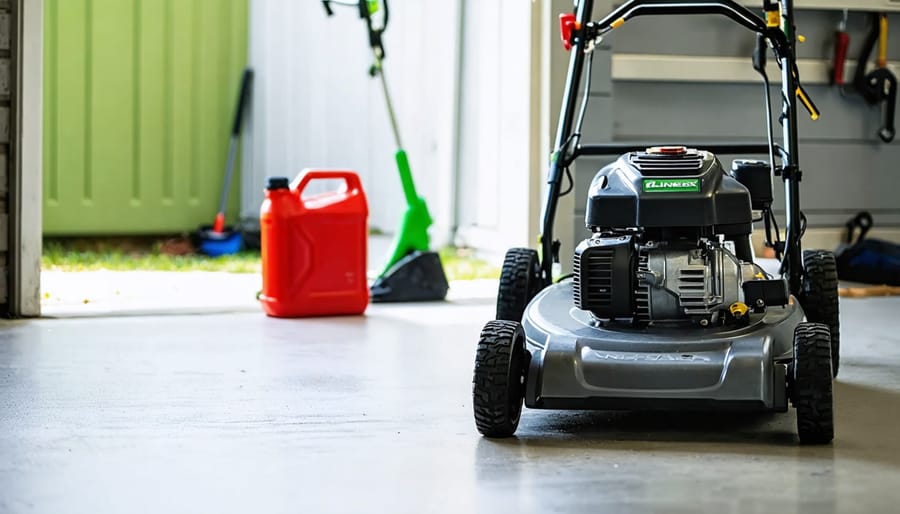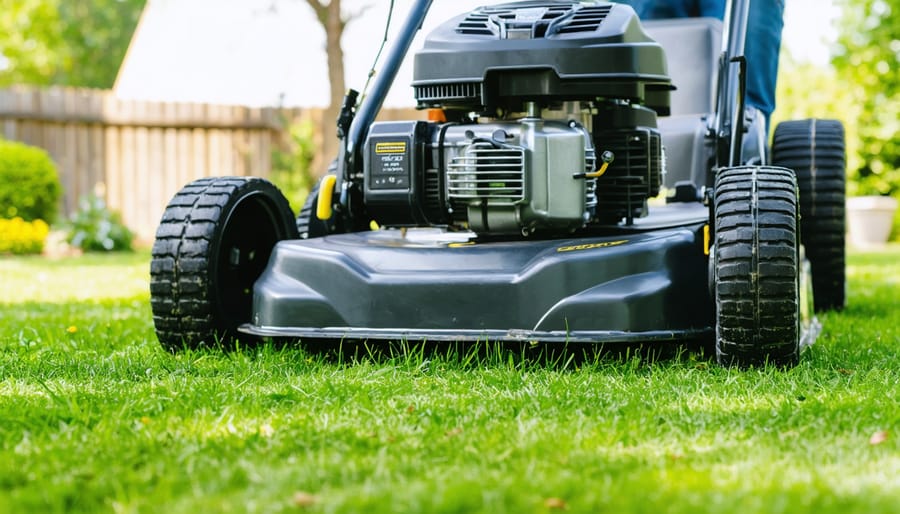Check your lawn mower’s fuel cap right now—if it says “2-cycle” or shows an oil-to-gas ratio like 50:1, you have a 2-stroke engine that requires mixed fuel. Most modern walk-behind mowers use 4-cycle engines with separate oil reservoirs, while many string trimmers, leaf blowers, and older lightweight mowers run on 2-cycle power.
The confusion between these engine types causes countless maintenance headaches every season. Pour straight gasoline into a 2-cycle engine, and you’ll seize the motor within minutes due to lack of lubrication. Mix oil into gas for a 4-cycle engine, and you’ll create excessive smoke, carbon buildup, and potential engine damage. Understanding which type powers your equipment isn’t just technical knowledge—it’s essential for keeping your lawn care tools running reliably for years.
Here’s the simple truth: 2-cycle engines are lighter, more compact, and deliver power with every revolution of the crankshaft, making them ideal for handheld tools and equipment you carry frequently. They burn oil mixed directly with gasoline for lubrication. Four-cycle engines are heavier but more fuel-efficient and environmentally friendly, with oil contained in a separate crankcase that you change periodically rather than burn.
This guide will show you exactly how to identify your engine type in under two minutes, explain the crucial maintenance differences between them, and help you troubleshoot the most common problems specific to each design—so you can maintain your equipment confidently and sustainably.
Understanding 2-Cycle vs. 4-Cycle Engines: The Basics That Matter
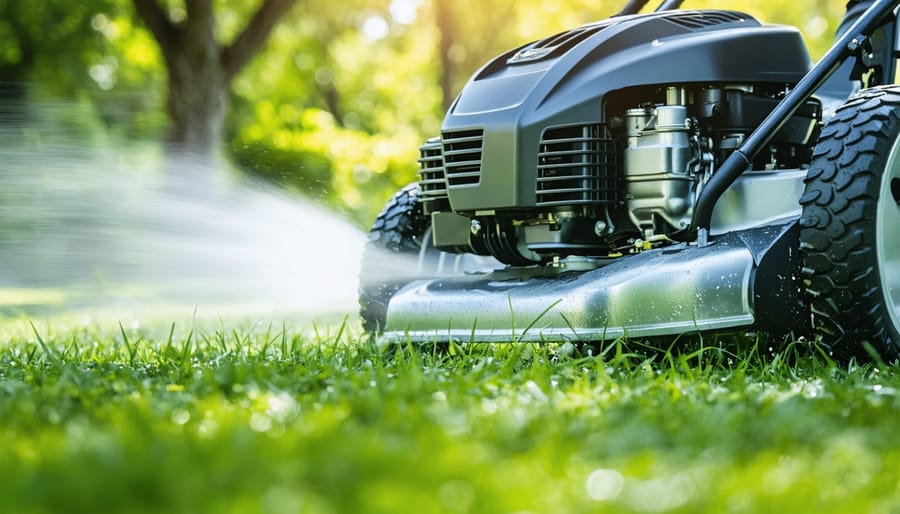
How 2-Cycle Engines Work
Understanding how 2-cycle engines work helps you make informed decisions about your lawn equipment—and whether you’re dealing with one in the first place!
A 2-cycle engine (also called a 2-stroke) completes its power cycle in just two piston movements—up and down—rather than the four movements of a 4-cycle engine. Here’s what makes them distinctive: you must mix oil directly into the gasoline before fueling. This oil-gas mixture lubricates the engine’s internal parts since 2-cycle engines don’t have a separate oil reservoir like their 4-cycle cousins.
You’ll typically find 2-cycle engines on handheld equipment like chainsaws, leaf blowers, string trimmers, and hedge clippers. Why? They’re lighter, simpler in design, and can operate at any angle—perfect when you’re wielding a trimmer or tilting a blower.
The trade-off? They’re generally louder, less fuel-efficient, and produce more emissions than 4-cycle engines. From a sustainability perspective, this is worth considering when purchasing new equipment. Many manufacturers now offer 4-cycle handheld tools as eco-friendlier alternatives.
The key takeaway: if you’re mixing oil with gas, you’ve got a 2-cycle engine. Most walk-behind lawn mowers, however, use 4-cycle engines with separate oil and gas tanks—making maintenance simpler and greener.
How 4-Cycle Engines Work
Most modern lawn mowers run on 4-cycle engines, and understanding how they work will help you maintain your mower more effectively. Think of a 4-cycle engine as having four distinct jobs it completes with every power cycle: intake, compression, combustion, and exhaust. It’s a beautifully efficient design that’s dominated lawn care equipment for good reason.
Here’s what makes 4-cycle engines special: they have a separate oil reservoir, meaning you’ll never need to mix oil with your gasoline. The oil stays in the crankcase (usually visible through a dipstick), lubricating the engine’s moving parts while the fuel system operates independently. This separation is a game-changer for weekend gardeners—no more measuring oil-to-gas ratios or worrying about incorrect mixtures damaging your engine.
The four strokes work like this: the piston moves down to draw in the air-fuel mixture, then compresses it by moving up, the spark plug ignites the mixture creating power, and finally the piston pushes out the exhaust gases. This complete cycle happens incredibly fast, powering your mower blade through thick grass with reliable consistency.
From a sustainability perspective, 4-cycle engines are the clear winner. They burn fuel more completely, produce fewer emissions, and don’t waste oil by burning it with the fuel like 2-cycle engines do. They’re also quieter and require less frequent refueling, making them the practical choice for environmentally conscious lawn care. For most homeowners, if your mower was manufactured in the last twenty years, you’re almost certainly enjoying the benefits of 4-cycle technology.
What Type of Engine Does Your Lawn Mower Actually Have?
Walk-Behind Push Mowers
If you’re shopping for or already own a walk-behind push mower, here’s some great news: nearly all modern models use 4-cycle engines. This shift happened years ago, making lawn care more convenient and environmentally friendly since you no longer need to mix oil and gas together.
How can you tell for certain? Look for a single fuel cap on your mower—that’s your telltale sign of a 4-cycle engine. You’ll also notice a separate oil fill cap, usually marked with an oil can symbol. These engines are quieter and produce less smoke than their 2-cycle predecessors, so if your mower runs relatively smoothly without that characteristic blue exhaust, you’ve got a 4-cycle.
The exception? Some older mowers from the 1980s and early 90s occasionally featured 2-cycle engines, but these are increasingly rare. If you’re experiencing issues like stalling or difficulty starting, it’s almost never related to fuel mixing concerns with push mowers. Instead, focus on troubleshooting starting difficulties through proper maintenance—checking your spark plug, air filter, and ensuring you’re using fresh, ethanol-free fuel when possible for better engine health and sustainability.
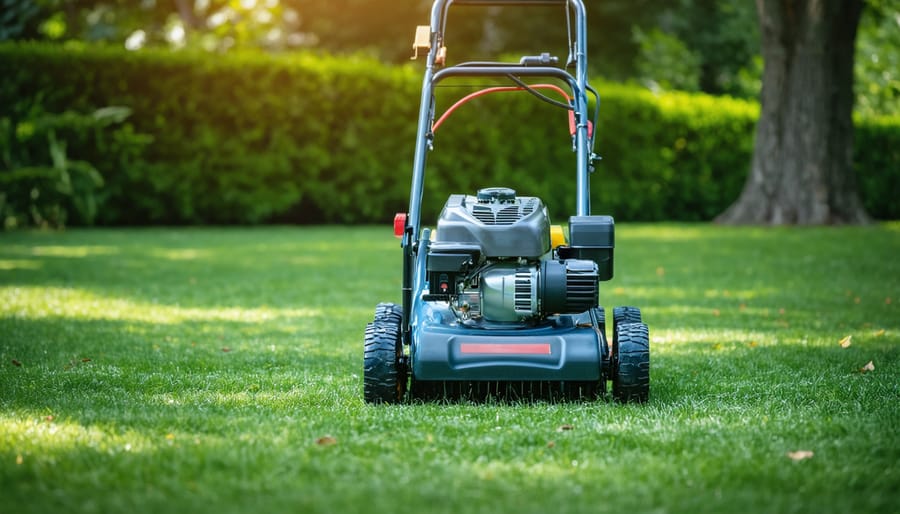
Riding Mowers and Zero-Turn Models
Here’s some good news if you’re shopping for or maintaining a riding mower: you’ll never need to worry about mixing oil and gas. All riding mowers and zero-turn models exclusively use 4-cycle engines—no exceptions. This universal standard exists because these larger machines demand reliable, sustained power that only 4-cycle engines can efficiently deliver. The heavier workload and longer operating times make the cleaner-burning, more fuel-efficient 4-cycle design the only practical choice. Plus, 4-cycle engines run quieter and produce fewer emissions, which aligns perfectly with sustainable lawn care practices. When you’re investing in a riding mower, you’re automatically choosing the more environmentally friendly option. Simply fill the tank with straight gasoline (no mixing required), keep the oil reservoir topped up with regular oil changes, and you’re set for hassle-free mowing sessions.
The Rare Exception: Older and Specialty Models
While the vast majority of walk-behind lawn mowers you’ll encounter today run on 4-cycle engines, there are some notable exceptions worth mentioning. If you’ve inherited an older mower or stumbled upon a vintage model at a garage sale, you might actually have a 2-cycle engine on your hands.
These older 2-cycle mowers were more common from the 1960s through the early 1990s, before environmental regulations and improved engine technology made 4-cycle engines the standard. You’ll also find 2-cycle engines on certain specialty equipment like some commercial edgers and trimming mowers designed for tight spaces.
How can you tell if you have one of these rare exceptions? Look for these telltale signs: a separate compartment or reservoir marked for oil-gas mixture, instructions on the fuel cap about mixing ratios (typically 32:1 or 50:1), or a significantly lighter overall weight compared to modern mowers. The owner’s manual—if you’re lucky enough to have it—will definitively state the engine type.
From a sustainability perspective, if you do own a vintage 2-cycle mower, consider whether it’s worth maintaining. These older engines produce considerably more emissions than modern 4-cycle alternatives and aren’t as fuel-efficient. However, keeping functional equipment in service rather than sending it to a landfill has its own environmental merit. Weigh the trade-offs based on how frequently you mow and your commitment to reducing your carbon footprint in lawn care.
Why This Matters: Mechanical Issues Specific to Each Engine Type
Common 4-Cycle Lawn Mower Problems
While 4-cycle mowers are generally more reliable than their 2-cycle cousins, they come with their own unique set of challenges that every lawn care enthusiast should understand. The good news? Most issues are preventable with proper maintenance and easily fixable when they do occur.
**Oil-Related Troubles**
Since 4-cycle engines have separate oil reservoirs, neglecting oil changes is the most common mistake I see. Dirty or low oil can cause excessive engine wear, overheating, and even complete engine failure. Check your oil level before each use—it takes just 30 seconds and can save you hundreds in repairs. If you notice excessive oil consumption or white smoke problems from the exhaust, you might have worn piston rings or valve seals. This is often a sign your engine needs professional attention.
**Carburetor Complications**
The carburetor in 4-cycle engines can become clogged with old fuel deposits, especially if you’ve left gas sitting over winter. This leads to fuel-related issues like rough running or stalling. The sustainable solution? Always use fresh fuel and add a fuel stabilizer if your mower will sit for more than 30 days. Regular carburetor cleaning—once per season—keeps things running smoothly.
**Valve Adjustments and Starting Issues**
As 4-cycle engines age, valve clearances can drift out of specification, causing hard starting, loss of power, or that frustrating situation where your lawn mower won’t start despite everything seeming fine. Most manufacturers recommend valve adjustment every 100-300 hours of operation. It’s a bit technical, so don’t hesitate to have a small engine shop handle this one.
Regular maintenance—clean air filters, fresh spark plugs, and quality oil—prevents most 4-cycle problems before they start, keeping your mower reliable for years to come.
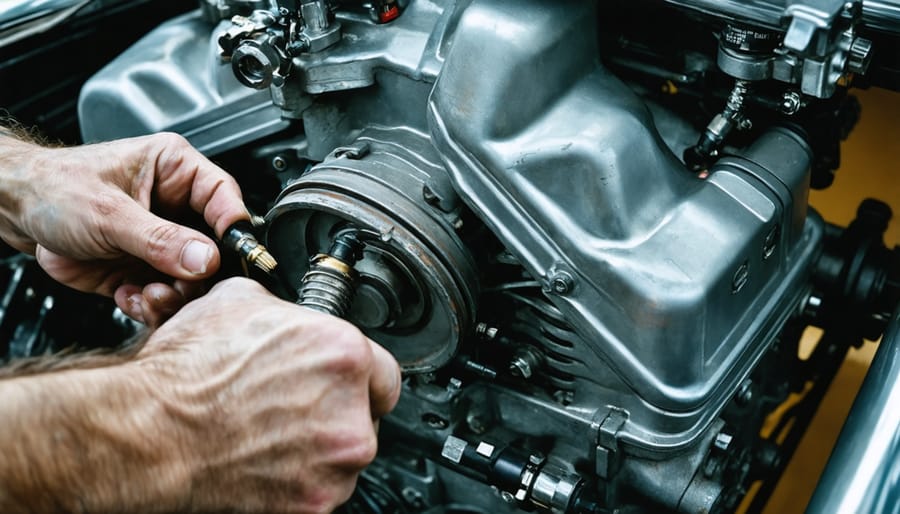
If You Do Have a 2-Cycle Mower: What to Watch For
If you’ve confirmed your mower runs on a 2-cycle engine, congratulations on solving the first mystery! Now let’s talk about keeping it running smoothly. These engines are wonderfully simple in design, but they do have their quirks that deserve your attention.
**Getting the Fuel Mixture Right**
Your biggest ongoing task is mixing fuel correctly—typically at a 50:1 ratio (that’s 2.6 ounces of 2-cycle oil per gallon of gas). I can’t stress enough how important this is. Too much oil creates excessive smoke and carbon buildup, while too little oil starves the engine of lubrication, leading to serious damage. Always use fresh, pre-mixed fuel or measure carefully with a proper mixing container. Old fuel breaks down quickly in 2-cycle engines, so only mix what you’ll use within 30 days. If you’re storing your mower, running it dry or using a fuel stabilizer is a sustainable practice that prevents waste and future headaches.
**Spark Plug Troubles**
2-cycle engines are notorious for fouling spark plugs because oil is constantly running through the combustion chamber. If your mower starts hard or runs rough, check the spark plug first—it’s often the culprit. Keep a spare plug handy and inspect it regularly for carbon buildup or oily residue. Cleaning or replacing fouled plugs is a simple fix that saves countless frustrating pull-starts.
**Compression Concerns**
Since these engines rely on a simple piston-ring seal, compression problems can develop over time. If your mower suddenly loses power or won’t start despite having spark and fuel, you might be facing worn piston rings. While this requires professional attention, catching it early through regular performance monitoring helps you plan for repairs rather than facing emergency breakdowns mid-season.
Maintenance Mistakes That Happen When You Misidentify Your Engine
I’ve seen plenty of well-intentioned gardeners create expensive headaches by mixing up their engine types—and trust me, these mistakes are easier to make than you’d think! Let’s talk about what can go wrong so you can avoid these pitfalls altogether.
The most catastrophic error? Adding pre-mixed fuel (oil and gas combined) to a 4-cycle engine. I once chatted with a neighbor who borrowed his friend’s 2-cycle trimmer fuel and topped off his lawn mower without thinking twice. Within minutes, his mower was belching blue smoke like a factory chimney. The oil coating on the spark plug caused misfiring, while the excessive oil in the combustion chamber created carbon buildup that required professional cleaning. He learned an expensive $200 lesson that day.
The reverse mistake—running straight gas in a 2-cycle engine—is even more devastating. Without oil mixed into the fuel, these engines lose their only source of lubrication. I’ve heard stories of seized pistons and destroyed engines after just one mowing session. The grinding noise as metal scrapes against metal is unforgettable, and unfortunately, it usually means you’re shopping for a replacement engine.
Another common slip-up involves oil changes. Beginners sometimes try changing oil in a 2-cycle engine (which doesn’t have a separate oil reservoir) or, conversely, never change oil in their 4-cycle mower because they assume it’s “maintenance-free” like a 2-cycle. Both scenarios lead to poor performance and shortened engine life.
Here’s my sustainable, practical advice: Take five minutes right now to positively identify your engine type using the methods we discussed earlier. Write it down on a piece of tape and stick it somewhere visible on your mower. Store only the correct fuel type in clearly labeled containers. These simple steps prevent mix-ups and protect both your investment and the environment from unnecessary waste and emissions caused by engine damage.
The Environmental Angle: Why 4-Cycle Engines Won Over
If you’re wondering why most modern lawn mowers have shifted to 4-cycle engines, environmental concerns played a starring role in this transition. Let me paint you a picture: those older 2-cycle engines, while simple and powerful, were essentially tiny pollution factories in your backyard.
Here’s the eye-opening truth: a traditional 2-cycle lawn mower could produce as much hydrocarbon pollution in one hour as driving a modern car for over 100 miles. That’s because 2-cycle engines burn oil mixed with gasoline, releasing unburned fuel directly into the atmosphere. About 30% of the fuel-oil mixture in a 2-cycle engine would actually escape unburned through the exhaust—not exactly what we want when we’re trying to create beautiful, sustainable outdoor spaces.
The Environmental Protection Agency took notice of this in the 1990s, implementing stricter emission standards that made 4-cycle engines the more attractive option for manufacturers. These cleaner-burning engines separate oil from gasoline, resulting in more complete combustion and significantly fewer emissions. We’re talking about an 80% reduction in harmful pollutants compared to their 2-cycle predecessors.
But it’s not just about cleaner air. Four-cycle engines are also more fuel-efficient, using about 30% less gasoline than comparable 2-cycle models. For those of us committed to sustainable gardening practices, this matters. You’re not only reducing your carbon footprint but also saving money on fuel costs over your mower’s lifetime.
The shift toward 4-cycle engines represents a genuine win for environmental stewardship without sacrificing the performance we need for effective lawn care. It’s one of those happy instances where doing right by the planet actually makes practical sense for our gardens and wallets too.
So, what’s the bottom line? The vast majority of modern lawn mowers—especially walk-behind and riding mowers—run on 4-cycle engines, which means you can breathe easy knowing you don’t need to mix oil with your gas. However, some smaller equipment like trimmers, leaf blowers, and older or budget-friendly lawn mowers might still use 2-cycle engines. The best thing you can do is take a few minutes to verify your specific model by checking the owner’s manual, looking for labels on the engine, or examining the fuel cap for mixing instructions.
Once you know what you’re working with, commit to following proper maintenance practices suited to your engine type. Regular oil changes for 4-cycle engines and correct fuel mixing for 2-cycle engines will keep your mower humming along for years to come.
And here’s a friendly reminder from one gardening enthusiast to another: whatever engine powers your mower, consider how you’re using it. Maybe this is the perfect time to explore sustainable lawn care practices—whether that means maintaining your equipment properly to reduce emissions, mowing at the right height to promote healthy grass, or even rethinking how much lawn you actually need. Your yard, your equipment, and the environment will all thank you for taking a thoughtful approach to lawn care!
